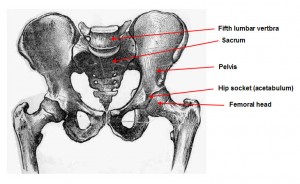 A muscle that does not get its notorious due when it comes to lower back pain is the rectus femoris, one of the four quadriceps muscles.
A muscle that does not get its notorious due when it comes to lower back pain is the rectus femoris, one of the four quadriceps muscles.
All of the quadriceps muscles –vastus lateralis, medialis, intermedius and the rectus femoris—extend the knee, but rectus femoris, the only one that connects to the pelvis, also flexes the hip.
The rectus femoris muscle is related to lower back pain due to poor posture.
Bad standing habits invariably include the leg bones sinking forward of the pelvis pushing into the tendon of the rectus femoris.
When people talk about hip flexor issues that are common in yoga, the gym and life, I believe they are most often talking about stress in the tendon of rectus femoris.
These problems usually manifest at the top of the thigh where it connects to the hip. When you attempt an action, no matter what muscles are supposed to do the work, the rectus femoris takes over, engaging, with the tendon popping like a steel cable being pulled taut (It is crazy to watch this happen!).
Our bones are meant to hold us up and ligaments hold the bones together.
The muscles, some of which do help with posture, are meant to move the bones. If the bones are poorly aligned muscles work overtime to support the skeleton when they shouldn’t have to.
When the leg bones sink or lean forward of the pelvis, the upper body usually leans backwards to compensate.
This lengthens the front of the body and shortens the back of the body. This is the first and foremost issue I am working with in my CoreWalking Program.
Good posture relates to an alignment of the bones that bears and transfers weight through the skeleton with as little extra effort as possible.
The bones sit one on top of the other (relatively) and muscles with balanced tone support the good alignment of the bones.
Poor posture means misaligned bones have got to be held up with additional forces— muscles, ligaments, and tendons and fascia—that will suffer in taking on work outside of their pay grades.
 A main problem with indecent orientation of the bones is the ligaments holding the bones together can get over stretched, or be habituated in a poor skeletal position.
A main problem with indecent orientation of the bones is the ligaments holding the bones together can get over stretched, or be habituated in a poor skeletal position.
This is happening with the iliofemoral ligament that connects the leg to the hip socket and underlays the rectus femoris.
And depending on the individual, the more the legs move forward the more the trunk leans backwards increasing the stress on both the iliofemoral ligament and the rectus femoris muscle making it harder if not impossible to properly align the spine.
There are three essential joints that we are looking at here. The two iliofemoral joints where the legs meet the pelvis and the lumbosacral joint where the lower spine meets the sacrum.
The lumbosacral joint is where so much back pain begins and degeneration occurs in large part due to the misalignment of the two iliofemoral joints.
If these two hip joints are as messed up as I suggest, there is no way for the bottom lumbar vertebrae (L5) to sit well on top of the sacral plate.
Changing our posture, which can have an amazing effect on lower back pain, has to start by getting the legs to fall directly under the hips sockets and pelvis.
Allowing the rectus femoris to live free of tension due to poor posture can also free the lumbar spine to sit directly on top of the sacrum allowing the space for movement and stability up and down the spine.
***



